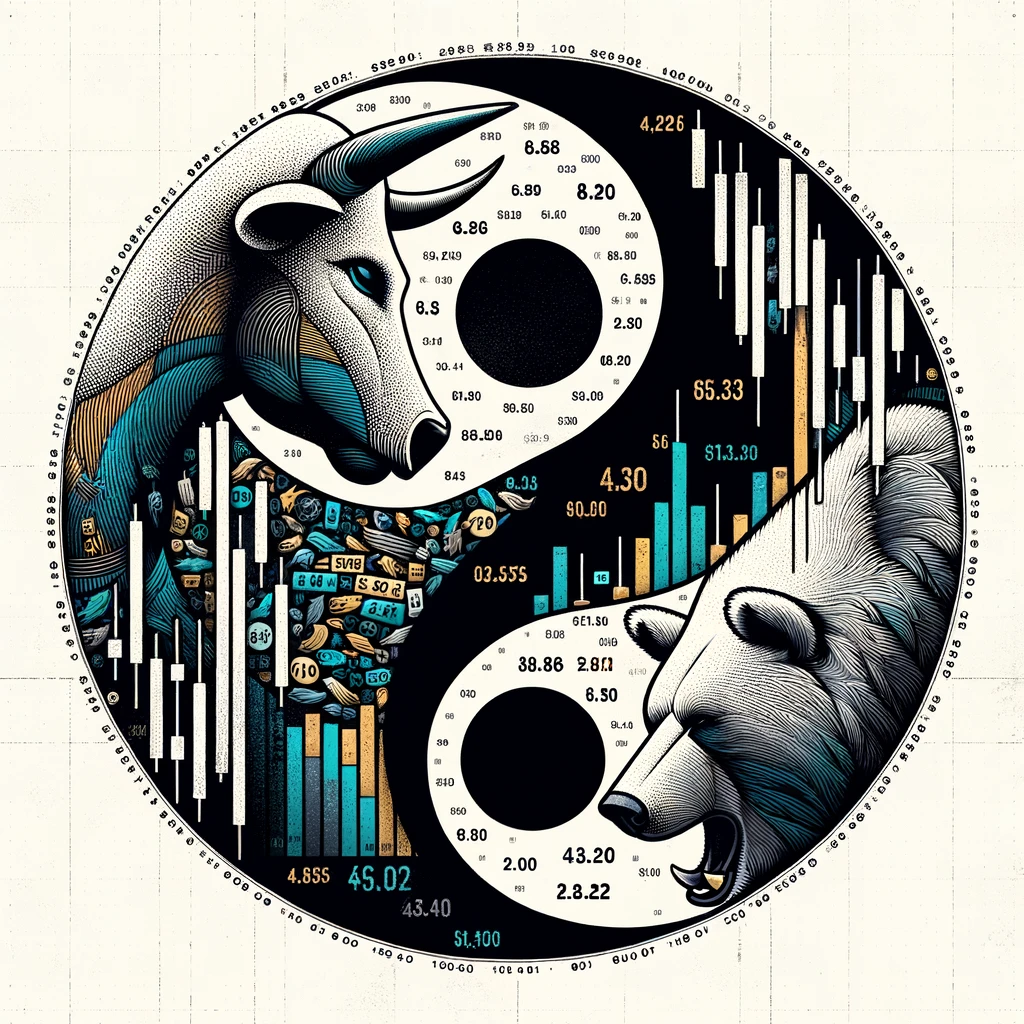Introduction to Option Straddles
An option straddle is a sophisticated investment strategy that involves the simultaneous entry of both a long and a short position on the same financial instrument. Typically, this is executed by buying and selling a call option and a put option for the same underlying asset, with identical expiration dates and strike prices.
In essence, an option straddle is a reflection of an investor’s strategy to hedge against the unpredictability of market movements. This approach is fundamentally distinct from conventional single-direction trading strategies, as it does not require a definitive forecast of market trends. Instead, it capitalizes on the magnitude of price volatility, irrespective of the direction. The duality inherent in a straddle—embracing both bullish and bearish outlooks within a single setup—allows traders to navigate through periods of ambiguity with a more balanced risk profile. By understanding the nuanced dynamics of option straddles, investors can employ a more versatile approach in their trading repertoire, adapting to a range of market conditions while managing potential risks and opportunities.
Table of Contents

Conceptual Framework of Option Straddles
The essence of the straddle strategy lies in its deployment during periods of significant uncertainty regarding price movements in the financial markets. The dual-directional nature of this strategy allows for the potential mitigation of losses, as gains in one position can offset losses in the other.
When executing an option straddle, an investor may opt to take a long position (buying both options) or a short position (selling both options). The outcome of this strategy is predominantly influenced by the magnitude of the price fluctuation of the underlying asset, rather than its directional trend.
This strategic framework is particularly advantageous in markets characterized by significant uncertainty or impending news events that could trigger substantial price movements. The beauty of the straddle strategy lies in its flexibility; it does not commit the investor to a single directional bet. Instead, it offers a unique symbiosis of both call and put options, each poised to leverage price movements in opposite directions.
This dual approach embodies a sophisticated understanding of market dynamics, where the investor’s profit potential is hinged not on the accuracy of predicting market direction, but rather on the intensity of market movement. As such, the option straddle strategy is a compelling choice for those who seek to benefit from volatility itself, turning what is often seen as a market risk into a strategic opportunity.
Interested In Learning More?
Criteria for Implementing a Straddle Trade
For an investment to qualify as an option straddle, it must adhere to specific criteria:
- The simultaneous purchase or sale of call and put options.
- The options pertain to the same underlying security.
- Identical strike prices for both options.
- Convergent expiration dates for these options.
These criteria are imperative for the successful execution of a straddle trade. This precision ensures that the strategy is well-positioned to capitalize on the volatility of the underlying asset, regardless of the market’s directional movement. It’s essential to understand that the alignment of strike prices and expiration dates creates a harmonized structure, allowing the movements in the call and put options to be effectively counterbalanced. This equilibrium is crucial for mitigating risks inherent in individual option positions.
Additionally, the selection of the underlying security is of paramount importance, as it must exhibit characteristics conducive to significant price fluctuations, thereby offering the potential for substantial gains from the option straddle strategy. In essence, a well-structured straddle trade leverages these criteria not just as guidelines, but as strategic pillars that underpin the entire approach, maximizing the opportunity to profit from market volatility while managing exposure to downside risk.
Optimal Utilization of the Straddle Strategy
The straddle options strategy finds its application in two primary scenarios:
- Directional Ambiguity: In highly volatile markets where price predictions are challenging, straddles are often employed. This is particularly true in situations of heightened implied volatility.
- Anticipation of Market Events: Option Straddles are also advantageous in the context of significant economic events (e.g., earnings announcements or fiscal policy changes), where pre-announcement market volatility is expected to be high.
The strategic deployment of option straddles is an art that requires not only a profound understanding of market dynamics but also an astute sense of timing. In scenarios of directional ambiguity, such as periods preceding major corporate announcements or economic events, the option straddle strategy shines by offering a balanced stance amidst uncertain outcomes. This strategic positioning is particularly potent during times of heightened implied volatility, where traditional directional bets are fraught with risk.
On the other hand, during volatility plays, the straddle acts as a tactical maneuver, harnessing the expected surge in price movement, irrespective of the direction. This dual applicability makes the option straddle an indispensable tool in the arsenal of a versatile trader. However, it is crucial for traders to recognize the opportune moment for strategy implementation and exit, as misjudging these can lead to escalated costs and diminished returns, particularly in fast-moving markets. Hence, the optimal utilization of the straddle strategy is a delicate balance of market analysis, timing precision, and risk management, tailored to navigate through the complex tapestry of market volatility.

Example of an Option Straddle
Consider the scenario where market volatility is pronounced, and the direction of price movement is ambiguous. Ideally, option straddles are most effective when the options have a lengthy duration until expiration and are at the money. Here, the trader aims to benefit from the disparity between the current values of the call or put options and their values at the initiation of the strategy.
For instance, assume a trader initiates a long straddle on Apple stock, which is trading at $60, by purchasing both call and put options at a strike price of $120. The call option costs $25, and the put option, $21, amounting to a total investment of $46. If the strategy is unsuccessful, the maximum loss is limited to this amount. However, if the stock appreciates to $210 at expiration, the put option becomes worthless, while the call option’s intrinsic value rises to $90, resulting in a net profit after deducting the initial investment.
The practical application of this strategy often reveals its multifaceted nature. Taking the Apple stock example further, the intricacies of market dynamics come into play. If the stock experiences an unexpected rally or decline, the option straddle strategy can yield significant gains due to the increased intrinsic value of one of the options. However, it’s crucial to understand the impact of time decay and implied volatility on the options’ premiums as the expiration date approaches.
These factors can erode the potential profitability of the position, underscoring the necessity for strategic timing in both entry and exit. This example not only illustrates the potential for profit in volatile markets but also highlights the importance of continuous market assessment and the agility to adapt to changing market conditions. In essence, the success of an option straddle lies in the delicate balance between the initial cost, the magnitude of the stock’s price movement, and the timing of the trade, making it a sophisticated strategy for experienced traders who can navigate these complexities.
Long vs. Short Straddle Strategies
In a long straddle, the trader buys both call and put options with congruent expiration dates and strike prices. This approach is favored when the underlying stock is perceived to be undervalued. Conversely, a short straddle entails selling both options, typically when the stock is considered overvalued. The risk in a short straddle is notably higher, as potential losses can exceed the premiums received from selling the options.
Each presents a distinct risk-reward profile tailored to different market expectations and trader temperaments. The long option straddle, often seen as a defensive strategy, excels in situations where significant price movements are anticipated, yet the direction remains uncertain. It appeals to the cautious investor who seeks to limit potential losses while maintaining the potential for substantial gains.
Conversely, the short straddle, typically a more aggressive tactic, is predicated on the belief that the underlying asset will experience minimal volatility. This strategy carries a higher risk, as potential losses can be substantial if the market moves significantly against the position. However, it offers the allure of earning immediate income from the premiums received. Both strategies require a nuanced understanding of market conditions and an inherent flexibility to adjust positions as market dynamics evolve. Successful implementation of either strategy demands not just an understanding of market fundamentals but also a keen insight into investor psychology and market sentiment, making them sophisticated tools in the hands of adept traders.

Conclusion
Option straddles represent a nuanced strategy in the realm of financial trading, offering opportunities to capitalize on market volatility while hedging against uncertain price movements. However, they require astute market analysis and timely decision-making to be effective.
In conclusion, an option straddle is a strategy that transcends conventional market predictions, allowing traders to harness the inherent volatility of the markets. The dual nature of a straddle, encompassing both long and short positions, offers a unique blend of risk mitigation and profit potential, making it an attractive approach for those who understand and respect the intricate dynamics of the financial markets. However, it’s imperative to acknowledge that the successful application of option straddles demands not only a deep understanding of market indicators but also a disciplined approach to risk management.
As with any sophisticated financial strategy, the use of an option straddle requires continuous learning, market vigilance, and an unwavering commitment to strategic adaptability. In a financial landscape that is perpetually evolving, the option straddle stands out as a versatile and dynamic strategy, capable of navigating through the unpredictability of market movements, offering investors a unique avenue to potentially profitable trading opportunities, while also reminding them of the importance of informed decision-making and risk awareness.









